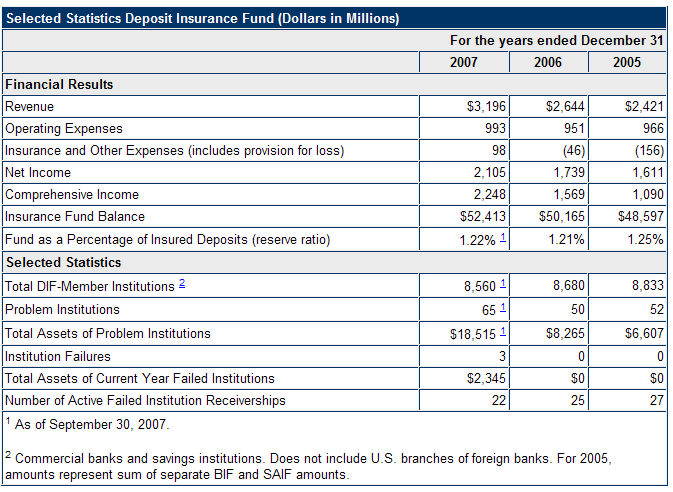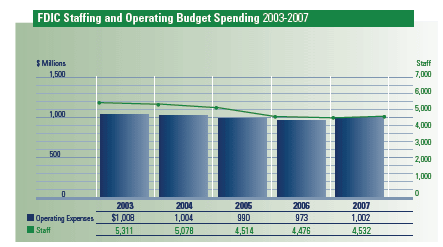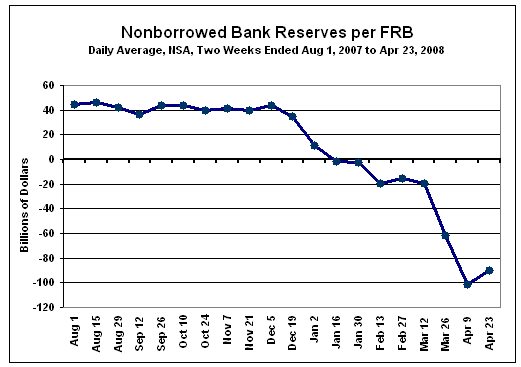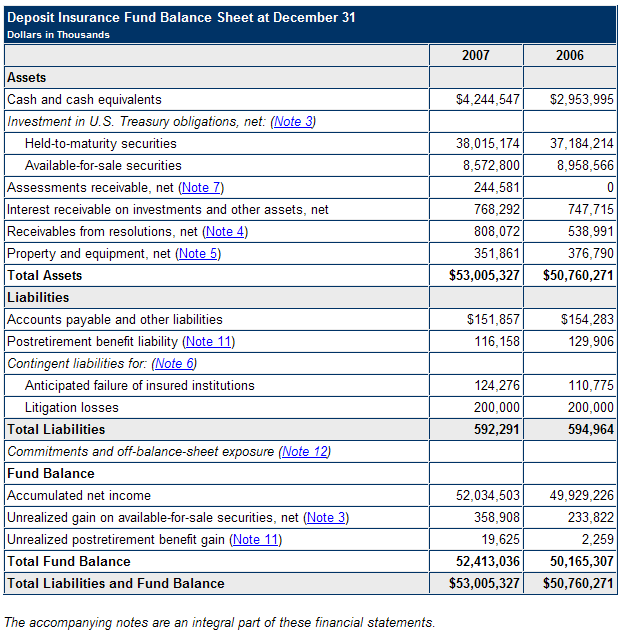![]()
Many American depositors in financial institutions take the guarantee of the Federal Deposit Insurance Corporation as iron-clad. The FDIC promises to cover the loss up to $100,000 per account if a covered institution is declared insolvent. Let us examine whether the guarantee is valid.
| First, there is a major difference between the amount of money in an account and the buying power that it represents over a period of time. For example, since January 2002, the U.S. dollar index has fallen by over 40% from 122 to 72. A simple understanding of economics would suggest that the dollar bought more in January 2002 than today. | |
| Second, with the failure of IndyMac and the possible failure of other small, medium and possibly large financial institutions, how strong is the FDIC? | |
| Third, if U.S. Treasury bonds and notes lose their AAA ratings, what effect might that have on the quality of assets held by the FDIC. | |
| Finally, do you understand the difference between wealth and fiat money, e.g., buying power? |
As of December 31st, 2007, the FDIC's reserve ratio was only 1.22% of Insured Deposits. Now in my book, that is a lot of leverage.
The following table shows some statistics for the FDIC. Net Operating income net of special assessments in 2007 was slightly over $2.1 billion.

The important numbers are the increase in problem institutions since 2005 and that during 2007, the FDIC closed only three institutions and the total assets of those institutions that failed in 2007 were only $2.3 billion. So far in 2008, the FDIC has closed five and the total assets were $32.3 billion, or 14 times higher. The bank failures are:
2008
January
Douglass National Bank, Kansas City, Missouri, with approximately $58.5 million in assets was closed. Liberty Bank and Trust Company of New Orleans, Louisiana has agreed to assume all deposits (approximately $53.8 million). (PR-7-2008)
March
Hume Bank, Hume, Missouri, with approximately $18.7 million in assets was closed. Security Bank, Rich Hill, Missouri has agreed to assume the insured deposits (approximately $12.5 million). (PR-21-2008)
May
ANB Financial, National Association, Bentonville, Arkansas, with approximately $2.1 billion in assets was closed. Pulaski Bank and Trust Company, Little Rock, Arkansas has agreed to assume the non-brokered insured deposits (approximately $212.9 million). (PR-33-2008)
First Integrity Bank, National Association, Staples, Minnesota, with approximately $54.7 million in assets was closed. First International Bank and Trust, Watford City, North Dakota has agreed to assume all deposits (approximately $50.3 million). (PR-41-2008)
July
IndyMac Bank, F.S.B., Pasadena, California, with approximately $32.01 billion in assets was closed. Non-brokered insured deposits and substantially all of the assets were transferred to IndyMac Federal Bank, F.S.B., Pasadena, California. The FDIC was named Conservator. (PR-56-2008)
The pace and size of bank failures appears to be increasing. During the 1st Qtr 2008, FDIC insured deposits increased 3.3 percent in the first quarter, and the Deposit Insurance Fund reserve ratio fell to 1.19%. From the First Quarter 2008 Quarterly Banking Profile of the FDIC comes this:
FDIC-insured commercial banks and savings institutions reported net income of $19.3 billion in the first quarter of 2008, a decline of $16.3 billion from the $35.6 billion that the industry earned in the first quarter of 2007. Insured institutions set aside $37.1 billion in loan-loss provisions during the quarter, as the asset quality of real estate portfolios continued to deteriorate. The average return on assets (ROA) was 0.59 percent, falling from 1.20 percent in the first quarter of 2007.
The FDIC is insuring a market sector whose earnings have fallen almost 50% in one year and one in which no one really knows how bad the situation will become. A prudent person might think that is a recipe for disaster.
The FDIC has been reducing its staff during the past several years. Operating expenses which are primarily staffing expenses will surely be increasing as the number of troubled institutions rise and failures mount. While the FDIC can increase its assessments on member institutions, any increase will also decrease profits of those institutions who are now struggling to remain afloat.

The 2007 FDIC annual report carried this interesting tidbit which now looks like the management of the FDIC did not have a clue as to what was going to happen in 2008.
Cost Reductions Realized through Staff Reductions
Salary and benefits costs represent more than 60 percent of the FDIC's annual Corporate Operating Budget. Because compensation costs are so significant, the FDIC has engaged in a continuing effort to realign staffing to reflect reduced workload requirements as it has moved past the banking and thrift crisis. Total FDIC staffing fell from 5,430 at the beginning of 2003 to 4,532 at year-end 2007, a 17 percent reduction over five years. As a result, aggregate spending for salaries and benefits decreased by 4 percent, from $666 million in 2003 to $639 million in 2007, despite an increase of 16.9 percent in the salaries of individual employees during this period.
Of course, the turmoil emanating from the sub-prime crisis was just beginning to cascade through the U.S. banking system. With the write-downs of over $450 billion already on the books since August 2007 and more showing up every day, the capital structure of many institutions are getting dangerously close to insolvency as shown by the Bear Stearns and IndyMac situations.
The FDIC's First Quarter 2008 report was interesting in the lack of understanding of the credit crisis shown by its management and CFO. In the report, the CFO stated that the fund would increase by $2.8 billion in 2008 and that the reserve ratio would increase to 1.25%. As we look forward into the second half of this year, those statements appear suspicious, at least.
In fact, Non-borrowed Bank Reserves per the Federal Reserve Bank (FED) were in negative territory in April 2008 for the first time since the early 1930's when President Franklin D. Roosevelt closed down the banks and confiscated all the gold owned by U.S. citizens at $20/oz. and a few days later, revalued it at $35/oz.
It was grand theft on a massive scale. Could it happen again ... yes, as all the laws allowing Roosevelt to do it remain on the books.
Banks are required to maintain a portion of their deposits on reserve at the FED. Hence, non-borrowed bank reserves should always be positive unless the system is insolvent.

Some analysts are currently suggesting that the total write-downs world-wide could exceed $1.6 trillion. With the new FASB rules requiring many institutions to bring back off-balance sheet transactions, the stage is set for further turmoil. Many banks both in the U.S. and abroad are having trouble raising capital to shore up their balance sheets. As liquidity disappears, the scene is set for further failures.
There is speculation as I write that Lehman Brothers, Wachovia, Merrill Lynch, Citibank, and many local and regional banks are in trouble. Of course, JPM was the recipient of a $75 billion tax-payer gift from the take-over of Bear Stearns but it still has the highest leverage ratios in the world because of its huge derivative positions. Don't you find it interesting that both Goldman, Sachs and JP Morgan, Chase have the largest derivative positions and yet, have written down far less than many of their counter-parts?
Some of these failures will end up with the FDIC liable for their guarantees.
The balance sheet of the FDIC as of December 31st is shown in the following table.

There are two important facts to note about the balance sheet.
|
First, as of December 31st, the FDIC only anticipated losses of insured institutions to amount to $124 million. Now with IndyMac alone estimated to cost between $4 to $8 billion, how realistic is their assumption about future losses? | |
|
Second, about $46.5 billion of their assets are held in U.S. Treasury securities and mostly at face value. Two questions arise. What is the market value of those securities today? What might the market value of those securities be if they lose their AAA rating? |
Thus, it should be apparent that if additional financial institutions go under, the staff of the FDIC will be swamped and their reserves will be significantly reduced, particularly, if another large institution fails. It should not be forgotten that many of these financial institutions are interwoven into a financial web. When one part of the web is torn, it affects the entire structure.
If the value of a U.S. dollar were constant and the Consumer Price Index (CPI) was flat, it might be argued that a dollar might be worth a dollar. Wealth, however, is based on the concept of purchasing power. As the U.S. dollar is falling and the CPI from the Ministry of Truth vastly understated, the FDIC guarantee should not be construed as a guarantee of wealth.
For centuries, gold has been known as the storehouse of wealth. The following chart of the U.S. dollar vs. gold should cause you some angst.

With the dollar falling and indications abroad that the ratings of U.S. Treasuries might be cut below AAA if the FED allows FNM and FRE access to the discount window, it would appear that the FDIC guarantee might be the least of your worries.
Still you might be well-served by keeping your deposits under $100,000 per account including C.D.'s. Of course, maintaining cash reserves outside the country might also be a good idea.
But then - 'Tis Only My Opinion!
Fred Richards
July 12, 2008
Corruptisima republica plurimae leges. [The more corrupt a republic, the more laws.] -- Tacitus, Annals III 27
This issue of 'Tis Only My Opinion was
copyrighted by Adrich Corporation in 2008.
All rights reserved. Quotation with attribution is encouraged.
'Tis Only My Opinion is intended to provoke thinking, then dialogue among
our readers.
![]()
![]() 'Tis Only My Opinion! Archive Menu
'Tis Only My Opinion! Archive Menu
Last updated - July 12, 2008